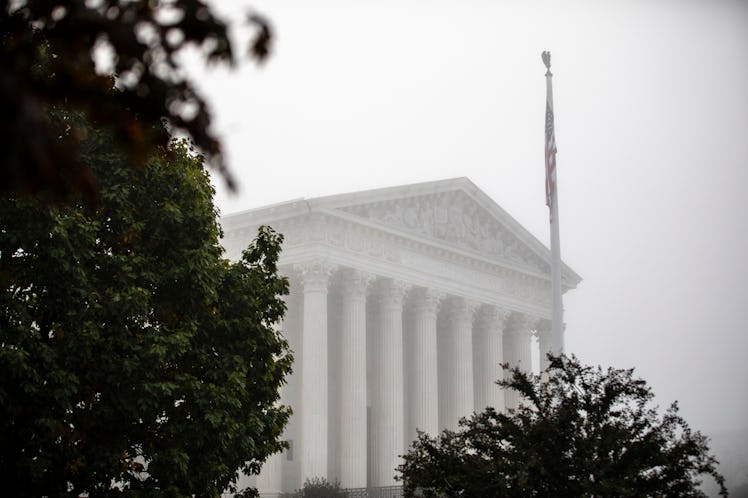
Here's What To Know About The Possibility Of Adding More Supreme Court Justices
As of Oct 22., Senate Judiciary Committee Republicans have voted unanimously in favor of moving forward with Amy Coney Barrett's advancement to the Supreme Court, setting the stage for a final vote on Oct. 26. Democrats have little maneuvering room to prevent Barrett's confirmation, meaning that many people are looking to the November presidential election — and the possibility of additional court nominees — as a potential strategy. But given that Barrett's confirmation would put the court back at a full nine members, many Americans are asking, is there's a limit to Supreme Court Justices? Here's everything you need to know about why court packing is on people's minds.
Barrett's nomination process, to fill the empty seat that liberal Justice Ruth Bader Ginsburg held before her Sept. 18 death, has been unusually speedy. While the average time to appoint a new justice runs about 70 days from nomination to confirmation, Republicans in Congress are pushing to have Barrett on the bench in barely a month. Barrett's nomination could solidify a conservative majority for the next generation, alarming Democrats who see the process as rushed in order to get ahead of the presidential election.
In light of Barrett's Sept. 26 Supreme Court nomination, thorny questions have arisen about whether Biden might defy tradition and "pack" the court, by appointing justices beyond the traditional nine. The Democratic candidate has mostly sought to avoid weighing in on the issue, but it's become harder to dodge the closer Barrett moves to confirmation. In an Oct. 20 interview with CBS News's Norah O'Donnell, Biden said that, if elected, he would appoint a bipartisan group of scholars to weigh in on the issue. "I will ask them to, over 180 days, come back to me with recommendations as to how to reform the court system," he said. "It's getting out of whack."
"It's not about court packing," he added. "There's a number of other things that our constitutional scholars have debated, and I'd look to see what recommendations that commission might make."
Legally, there's no consistent limit on how many justices sit on the court. Although Article III of the Constitution establishes the powers of the court, the document ordains Congress with the power of organizing it, meaning that the legislative branch decides how big the court is. In the early years of American history, Congress repeatedly adjusted the size of the court (usually for political reasons), and the number of Supreme Court justices has fluctuated from as few as five in 1801 to as many as ten in 1863. However, in 1869, in the aftermath of the Civil War, Congress upgraded the court from seven to nine members, and that's where it's stayed ever since.
Presidents have tried to use the process to their advantage before. In 1937, President Franklin Delano Roosevelt appealed to Congress in an attempt to expand the court to 15 justices, ostensibly to ease the burden on more elderly members of the court. However, it was widely understood that Roosevelt's effort to pack the court was an attempt to build judicial support for his New Deal, parts of which kept getting struck down in court. Congress did not approve of the attempted work-around, and it ultimately failed in the Senate.
Although Supreme Court justices don't officially hold partisan alignments, political scholars traditionally reference members' previous judicial records as a road map to predict how they might rule in future cases. Barrett, who Trump's third appointee to the court, has an extensive history of taking stringent right-wing stances on issues such as health care, reproductive rights, immigration legislation, LGBTQ+ matters, and more during her time as a member of the 7th U.S. Circuit Court of Appeals. Should Barrett be confirmed, liberals are concerned Trump would have a better chance than ever to solidify a conservative majority in the court, possibly allowing him to make good on his 2016 promises to repeal the Affordable Care Act and overturn the landmark abortion rights case Roe v. Wade.
With a mere 12 days until Nov. 3, American voters are already weighing in en masse — as of Oct. 22, over 42.1 million early voters have already cast their ballots, indicating a potential surge in ultimate voter turnout, per The Washington Post. At the polls or by asking tough questions, people are clearly ready to weigh in on the direction the United States takes in the next four years.